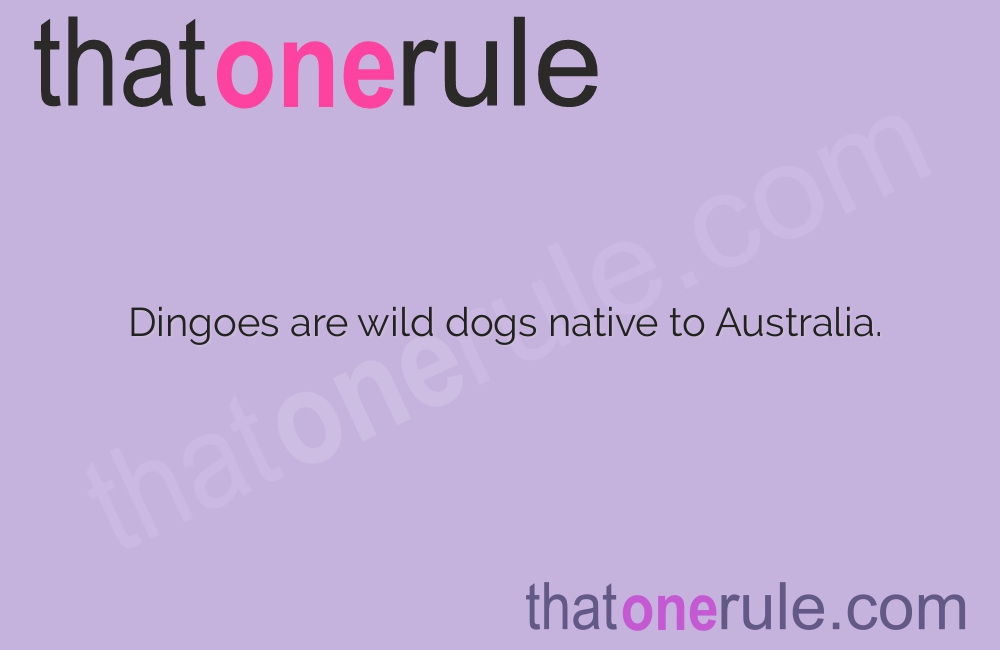Dingo Facts

Dingoes are wild dogs native to Australia.
Dingoes are believed to have arrived in Australia over 4,000 years ago.
Dingoes are excellent hunters and can take down animals larger than themselves.
Dingoes have several unique vocalizations, including a howl that can be heard over long distances.
Dingoes have the ability to rotate their heads almost 180 degrees.
Dingoes have a highly-developed sense of smell, which helps them in tracking down prey.
Dingoes can travel long distances in search of food, covering up to 40 kilometers in a single day.
Dingoes have well-developed muscles, allowing them to jump and climb with ease.
Dingoes have been known to form complex social structures, living in packs with a dominant alpha male and female.
Dingoes are highly adaptable and can survive in a variety of habitats, including deserts, forests, and grasslands.
Dingoes have a lean body structure, allowing them to move swiftly and silently.
Dingoes have a bushy tail that helps them maintain balance while hunting and running.
Dingoes primarily hunt at dawn and dusk, taking advantage of low light conditions.
Dingoes are known for their intelligence and problem-solving abilities.
Dingoes have a lifespan of up to 10-15 years in the wild.
Dingoes are carnivorous, with a diet consisting mainly of small to medium-sized mammals, birds, and reptiles.
Dingoes have bushy, pointed ears that can be rotated independently to detect sounds from different directions.
Dingo Facts part 2
Dingoes are highly territorial and will mark their boundaries with scent markings and vocalizations.
Dingoes play a crucial role in maintaining the ecological balance by preying on pest species.
Dingoes have a strong jaw and sharp teeth, allowing them to tear through flesh and bones effortlessly.
Dingoes have a wide variety of coat colors, including shades of tan, brown, and black.
Dingoes have been known to exhibit playful behavior, especially when they are young.
Dingoes are skilled swimmers and can cross rivers and streams to reach new territories.
Dingoes communicate through a range of facial expressions, body postures, and vocalizations.
Dingoes have a strong sense of loyalty towards their pack members and will defend them against threats.
Dingoes have a strong maternal instinct and provide excellent care for their young.
Dingoes are highly independent animals and prefer to roam freely rather than being confined.
Dingoes have been depicted in various forms of Australian art and folklore.
Dingoes have been domesticated in some instances, but they still retain their wild instincts.
Dingoes have a keen sense of hearing, allowing them to detect the slightest sound of movement.
Dingoes are known for their agility and can navigate through rugged terrains effortlessly.
Dingoes have a hierarchy within their packs, with dominant individuals having priority access to food and mating partners.
Dingoes have been a subject of scientific research to understand their genetic origins and evolution.
Dingoes are efficient scavengers and can survive on carrion during times of scarcity.
Dingoes have a strong sense of smell to locate sources of water in arid environments.
Dingoes are elusive creatures and are often difficult to spot in the wild.
Dingoes have been featured in several documentaries and films, showcasing their unique behavior and survival strategies.
Dingoes have a unique ability to adjust their hunting techniques based on the type of prey they are targeting.
Dingoes have been known to form symbiotic relationships with other animals, such as kangaroos and wallabies.
Dingoes have a social structure that revolves around a dominant breeding pair, which are usually monogamous.
Dingoes have been found to exhibit problem-solving skills similar to those observed in domestic dogs.
Dingoes are excellent escape artists and can dig under fences or climb over obstacles to gain freedom.
Dingoes have adapted to the harsh Australian climate, with their thick fur providing insulation during cold nights.
Dingoes have a heightened sense of awareness, making it difficult for predators to sneak up on them.
Dingoes are a symbol of Australia’s rich biodiversity and have captured the fascination of people around the world.